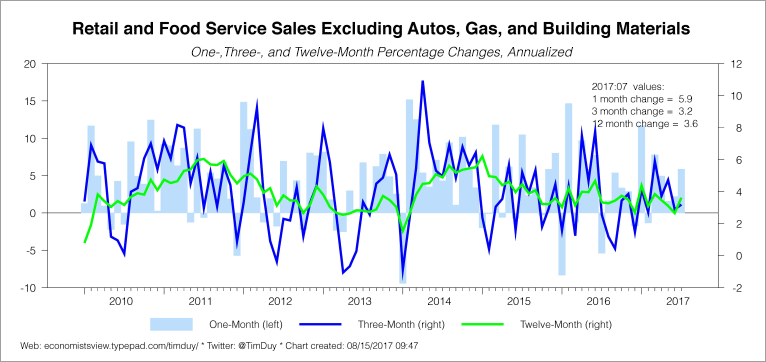Some quick thoughts for the day.
First, New York Federal Reserve President William Dudley gave an extended interview to the Associate Press. Definitely worth the time to read. Some highlights:
1.) Dudley never put a Trump bump in his forecast, so his forecast is essentially unchanged:
I think we’re still on the same trajectory we’ve been on for several years. Above trend growth, gradually tightening labor market, inflation — somewhat below our objective — but we do expect as the labor market continues to tighten, to see firmer wage gains and that will ultimately filter into inflation moving up towards our 2% objective.
2.) He expects inflation numbers to improve. He wants us to ignore the year-over-year numbers (of course, recent month-over-month numbers are not great):
Well, the reason why inflation won’t get up to 2% very quickly on a year-over-year basis is because we’ve had these very low inflation readings over the last 4 or 5 months. So it’s going to take time for those to sort of drop out of the year-over-year calculation.
3.) Assuming the forecast continues as he expects, he believes the Fed will hike rates again:
I think it depends on how the economic forecast evolves. If it evolves in line with my expectations, I would expect — I would be in favor of doing another rate hike later this year.
4.) Bubble? What bubble?
My own view is that — I’m not particularly concerned about where our asset prices are today for a couple of reasons. The main one is that I think that the asset prices are pretty consistent with what we’re seeing in terms of the actual performance of the economy.
5.) But - and I think this is important - financial conditions continue to easy despite rate hikes:
Now the reason why I think you’d want to continue to gradually remove monetary policy accommodation, even with inflation somewhat below target, is that 1) monetary policy is still accommodative, so the level of short-term rates is pretty low, and 2) and this is probably even more important, financial conditions have been easing rather than tightening. So despite the fact that we’ve raised short-term interest rates, financial conditions are easier today than they were a year ago.
The stock market’s up, credit spreads have narrowed, the dollar has weakened, and those have more than offset the effects of somewhat higher short-term rates and the very modest increases that we’ve seen in longer-term yields.
6.) Balance sheet normalization is coming:
Well, we obviously have to have the FOMC meeting to make that decision at the next FOMC meeting. But, I don’t think the expectations of market participants are unreasonable. In June, following the June FOMC meeting, we laid out a plan in terms of how we would actually do our balance sheet normalization. How we would allow Treasury and agency mortgage-backed securities to gradually run off our portfolio over time.
And so the plan is out there. It’s been I think generally well-received, and fully anticipated. People expect it to take place. In the last FOMC statement, we said that we expected this to happen relatively soon. So, I expect it to happen relatively soon.
7.) At the end of the day, the balance sheet reduction might amount to very little:
My own view is, if I had to say today, we’re probably going to see a balance sheet five years from now that’s probably in the order of 2-1/2 to 3-1/2 trillion rather than the 4-1/2 trillion dollar balance sheet.
Overall, Dudley continues to adhere to what amounts to the Fed's median forecast, and that means he thinks another rate hike this year is solidly in play.
Separately, retail sales for July were up:
The monthly data is noisy, so be wary that it reflects the true state of spending. The three-month and twelve-month changes (for core sales) are similar at 3.2% and 3.6% respectively and more likely reflect the underlying trend. Basically, the consumer continues to press forward at a modest pace. Stop worrying about consumer spending. It isn't an imminent threat to the outlook.
And why should it be a threat? Like, job growth, wage growth is actually fairly solid. The headline weakness in wage growth is all about demographic shift, at least according to new research from Mary Daly of the Federal Reserve Bank of San Francisco. Via Bloomberg:
Fresh research from the San Francisco Fed provides an explanation: baby boomers. As they retire in droves, their exit from the workforce is distorting the data for average earnings, according to a blog post published Monday on the bank’s website.
“Wage growth isn’t as disappointing as it looks,” Mary Daly, director of economic research at the San Francisco Fed, said in an interview. “Wage growth, when cleaned up, looks consistent with other measures seen in the labor market.”
The implication is that the labor market low wage growth does not necessarily imply the labor market is weak. It is an artifact of demographic change. That change has been fairly persistent, but at the end of the note Daly holds out some hope that it may be changing:
Overall, these factors have combined to hold down growth in the median weekly earnings measure by a little under 2 percentage points (Figure 2), a sizable effect relative to the normal expected gains.
Most recently, the effect from flows into and out of full-time work has started to tick upward and might be a sign of stronger growth ahead.
We will see.
Finally, you can find my latest at Bloomberg Prophets.







